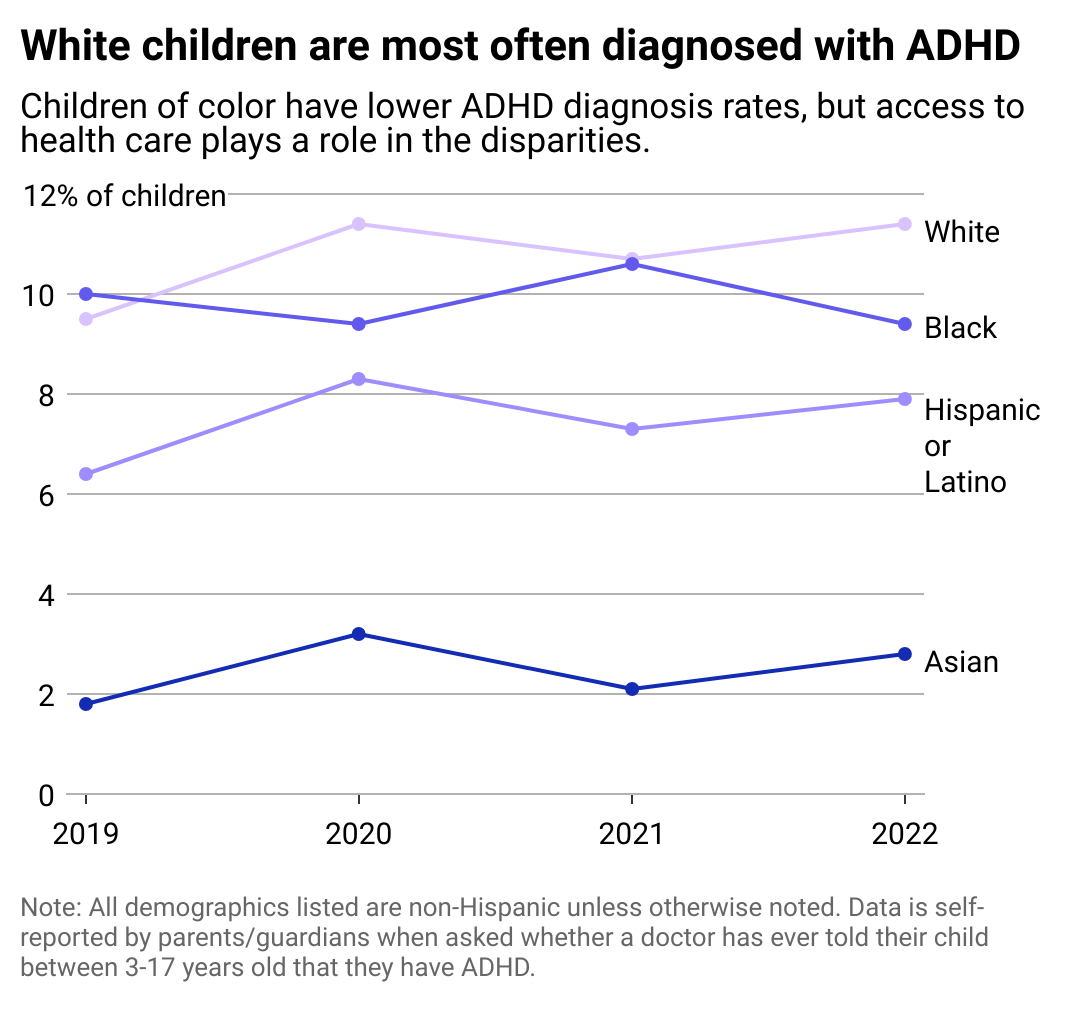
Black, Asian, and Hispanic children are less often diagnosed with ADHD
This story originally appeared on ADHD Advisor and was produced and distributed in partnership with Stacker Studio.
Black, Asian, and Hispanic children are less often diagnosed with ADHD
Rates of ADHD diagnosis among children and adolescents skyrocketed by over 85% between 1997 and 2022. The exact cause for this stark increase is unknown. However, theories exist, from changing expectations of how children should behave to increased awareness of symptoms and higher use of social media. The COVID-19 pandemic may have also exacerbated symptoms among those already living with ADHD.
White children are more likely to receive an ADHD diagnosis than Black, Asian, and Hispanic children. Even so, this doesn't necessarily mean white children are more susceptible to the condition; instead, some suggest other ethnic groups are underdiagnosed for reasons ranging from less access to health care to clinician bias. Whatever the cause for diagnostic disparities, ultimately, this means many children and adolescents are left to struggle in silence without the support they need.
Inattention, hyperactivity, and impulsivity that disrupt daily life are key symptoms of ADHD. Around 6 million children ages 3-17 in the U.S. were diagnosed with the condition between 2016 and 2019, but not all children who have symptoms receive a diagnosis. Diagnosing ADHD can be challenging, as symptoms may overlap with certain developmental stages—such as toddlerhood—as well as other mental health conditions, including depression and anxiety.
Complicating matters further, there is currently no specific test for diagnosing ADHD in children. An evaluation usually involves gathering feedback from multiple parties, including the child, their parents or caregivers, health care providers, and teachers for a behavioral assessment.
ADHD Advisor used data from the Centers for Disease Control and Prevention to examine racial disparities in ADHD diagnoses. Data is self-reported by parents or guardians of children diagnosed with ADHD by their doctor. Insufficient data was available for Alaska Native and American Indian students and Native Hawaiian and Pacific Islander students.
Research published
A 2021 study published in JAMA Network found that white children were diagnosed with ADHD more than any other group of children, while Black children were more often diagnosed than Hispanic or Asian children. However, a lower proportion of diagnoses doesn't necessarily mean one group has a higher or lower prevalence of ADHD than others. Though the precise cause of these disparities is not fully understood, various theories exist to explain the gaps.
A 2020 study published in JAMA Psychiatry found that, contrary to what was written in the fifth edition of the Diagnostic and Statistical Manual of Mental Disorders at the time, Black individuals are more likely to have ADHD than the general U.S. population. Some said ADHD may go underdiagnosed in Black children due to factors including parental beliefs about ADHD and less access to adequate health care.
Other research suggests culture also has an impact. Different cultures may find ADHD symptoms more or less problematic. For example, a 2021 study published in JAMA Network Open found that Asian parents were more likely to bring their children in for clinical evaluation for different reasons than other racial groups.
Model minority stereotypes might play a role as well. Some accounts suggest parents, teachers, and clinicians may dismiss ADHD symptoms in Asian children should they generally conform to stereotypical behaviors such as doing well in school or being "quiet" and "scholarly."
Hidden biases may also contribute to underdiagnosis. A 2019 study published in Academic Psychiatry found that clinicians may interpret symptoms of ADHD differently among children from different backgrounds. While white children with hyperactivity may be diagnosed with ADHD, a Black child with the same symptom may be diagnosed with oppositional defiant disorder or conduct disorder, leading to harsher disciplinary action in school rather than support.

Examining diagnosis disparities
ADHD is highly treatable when properly diagnosed. When left undiagnosed, however, the condition can harm an individual's mental health, quality of life, and academic performance.
Support exists for students diagnosed with ADHD. An Individualized Education Program provides such services as a modified curriculum, counseling, and specialized instruction for individuals up to age 22. Additionally, a 504 Accommodation Plan provides support, like frequent breaks at school and modified homework assignments.
However, the challenge for many may be receiving a diagnosis in the first place. Underlying racial biases may influence how symptoms of ADHD are perceived. For example, while hyperactivity may be considered a mental health condition in white children, it may be considered as defiance in others, leading to harsher disciplinary action.
Racial disparities in ADHD diagnoses are just one instance of structural inequalities in health care. These disparities have unfortunately persisted for two decades, despite increased activism and awareness in recent years. More work is thus needed to ensure equal access to health care, regardless of skin color.
Story editing by Elsie Drexler. Copy editing by Paris Close.



